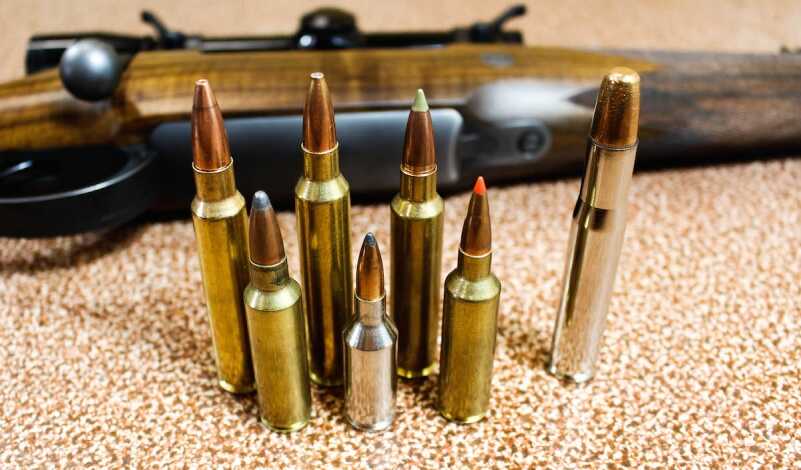
A lot of renowned rifle cartridges were born from earlier famous cartridges. An example is the .404 Jeffery, which spawned all kinds of cartridges. L-R .338 RUM, .300 WSM, .300 RUM, .25 WSSM, .30 Nosler, .270WSM and .404 Jeffery.
Cartridge development has an interesting and sordid history; the cartridges we have come to know and love – more often than not – are based on an existing design, modified to suit the shooting public’s needs. Some of our most famous cartridges, ones we have used and read about for decades, have a lineage that may surprise you. There are foregone conclusions that have led to misconceptions about the function of certain features, and some relationships that might seem obvious once pointed out, but have been buried over the years. Let’s take a look at some of the family trees of cartridges, and see how they’ve intermingled and branched.
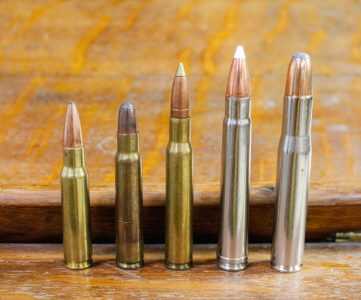
The proud parents of so many great cartridges. L-R .308 Win., 8x57mm Mauser, .30-06 Springfield, .375 H&H Magnum, .404 Jeffery.
The 8x57mm Mauser
In the late 1880s the German military developed a cartridge for one of Peter Paul Mauser’s rifles: the 7,92x57mm, or as we know it better, the 8mm Mauser. Using a rim diameter of 0.473” and a 57mm case length, the 8×57 would actually be the father of one of the most influential German cartridges of all: Peter Paul Mauser’s 7x57mm. That 7mm Mauser would go on to become a fantastic sporting round (I feel it makes one of the best deer guns ever), as well as a military service round that would star in a battle that spurred the U.S. Army to develop what may be the most popular cartridge in North America – the .30-’06 Springfield. More about that in a moment.
SEE ALSO: The CZ 550 American Safari Magnum in .375 H&H — Full Review
The 57mm case length would go on to fight numerous battles; Spain and many of her colonies would adopt it as their standard issue round, and the 8×57 saw service in two World Wars in the hands of German soldiers, with good effect. But that case was not lost on the sporting world either. In fact, the surplus military rifles and abundant ammunition caused the wildcatters to begin their notorious experimentation. It wasn’t long before cartridges like the 9x57mm Mauser and 9.3x57mm Mauser popped up from European rifle makers, and here in the States, guys like Ned Roberts would neck that case down to hold .257” diameter bullets, giving us the .257 Roberts. Remington took that one step further down, developing the .244 Remington – or 6mm Remington, depending on the era – which would have been the 6mm standard were it not plagued by a poor choice of twist rate.
Beside the famous commercial cartridges that have been used around the world, there are quite a few wildcats that still get mentioned from time to time, like the 6.5x57mm, which makes a good blend of case capacity to bore diameter.
The 8×57 went through its changes early on, specifically a bullet diameter shift from .318” to .323”, but this venerable design is still sound, and a hunter who knows how to shoot his 8×57 is well equipped for most of the world’s game animals, save the true heavyweights.
The .30-’06 Springfield
A small disagreement between the Kingdom of Spain and the United States of America, on the Caribbean island of Cuba, led to a major upheaval in the U.S. Army’s thoughts on cartridge design. Yes, we won the argument, but the Spanish soldiers – who were using the 7×57 Mauser we just discussed – were clearly better equipped than the Rough Riders et al. who were using the .30-40 Krag, with its 220-grain round nose slug at a very moderate velocity. Once the dust settled, and Spain was evicted from North America, the U.S. Army’s Ordinance Department began to develop a new cartridge, with a case that borrowed some features of the Mauser design. They ultimately decided to keep the 220-grain, .308” diameter bullet, but in a new case that would greatly improve on the muzzle velocities. The .30-’03 was a definite upgrade to the ballistics of the .30-40 Krag, but within three years was replaced by what would become an international wonder: “Cartridge, Ball, Caliber .30, Model of 1906.”
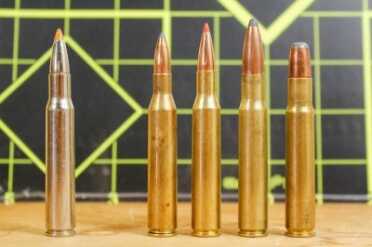
The ’06 Family Portrait: L-R .30-06 Spfd., .25-06 Remington, .270 Winchester, .338-06 A-Square, .35 Whelen. Absent from photo is .280 Remington, who doesn’t speak to the .270 Winchester.
The ’03 neck was shortened a smidgeon, the projectile weight was reduced from 220 grains to 150 grains, and the shooting world was knocked head-over-heels in love. There is absolutely no doubt that the .30-’06 Springfield remains one of our most treasured cartridges to this day, but oh! the children that this military wonder has sired!
I’ve read numerous stories about the designs that the Army had considered while sitting at the drawing board, developing the aught-six. One, pretty reliable I might add, included switching bullet diameters from .308” to .277” – in effect, this may have been the precursor to the crown-prince of the Springfield line: the .270 Winchester. Released just 19 years after the father was born, the .270 was available in the reliable Winchester Model 54 bolt-action rifle, and stepped the speeds up a notch. With an effective bullet weight range of 90 to 150 grains, it made (and still makes) good sense as an antelope/deer/elk rifle, and the musings of Jack O’Connor did much to inflate the cartridge’s popularity. Ninety-one years after its release, it remains a top seller.
Even earlier than the .270 Winchester – though it would take 57 years to be declared legitimate – Charles Newton necked down the .30-’06 case to hold .257” bullets, effectively introducing the world to what would become the .25-06 Remington. Though a bit light for game animals larger than deer, the .25-06 Remington makes a flat-shooting, hard-hitting choice for animals in that weight class. A good 117- or 120-grain bullet will handle the largest deer, and some of the lighter bullets make a great choice for distant pronghorns, providing the wind isn’t blowing a gale that day.
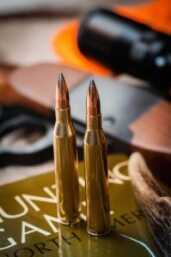
Remington’s .25-’06 is a good deer/pronghorn choice, giving flat trajectory and decent wind bucking capabilities.
Remember I mentioned all those surplus 7mm bullets floating around? It made perfect sense to mate the ’06 case with a 7mm projectile, and Remington did just that in 1957 – unveiling the .280 Remington. Personally, I like this cartridge best of any of the ’06 offspring smaller than .30 caliber, as it offers the wide choice of bullet weights that will suffice for 90% of any hunting on earth. Slow sales prompted Remington to rename the cartridge the “7mm Express Remington” in 1979, but that just seemed to confuse things, and Big Green reversed the nomenclature two years later. Often compared to the .270 Winchester, the two cartridges don’t speak at family functions.
Going larger than .30 caliber, we’ll find some interesting cartridges who call the Springfield “Daddy.” The .338-06 A-Square is, undoubtedly, a highly efficient design, fully capable of taking any North American game confidently, yet will still benefit from the lighter bullets within the caliber to make a good all-around choice. I’ve seen this cartridge push the big 250-grain slugs to 2,400 fps, and that combination of velocity and high Sectional Density will ruin even a grizzly bear’s day. African plains game, and even the dangerous cats can be taken quite neatly, as this cartridge essentially reproduces the ballistics of the classic .318 Westley Richards. Load some of the 180-grain bullets in the .338-06, and you’ve got a perfectly viable deer gun in hand.
The .35 Whelen – named in honor of Col. Townsend Whelen – sees the ’06 case opened up to .358 caliber, and makes for quite a thumper. There are others – more obscure, yet effective – like the .400 Whelen, which confirm the fact that Springfield case makes a damned fine choice for most of the popular bullet diameters.
Military Favorite Son, Take Two
Despite the success of the .30-’06 Springfield, the Army Ordnance Department had begun to search for a lighter, yet no less effective replacement for the ’06. Initial research began with the .300 Savage, yet culminated in what was dubbed the T-65; the sporting world would know it better as the .308 Winchester. In fact, the sporting version was released two years prior to the official military adoption. Now, 60-plus years later, despite the campfire arguments that rage on when comparing and contrasting the .308 and ’06, there’s absolutely no denying that the .308 Winchester is both a fantastic target round and a wonderful big game cartridge. Like the .30-‘06, there have been some children of that case that have rocked the shooting world. American wildcatters couldn’t resist tinkering with the different possibilities of necking that short case, both up and down in caliber. In 1955 Winchester themselves released two variants of the .308 Winchester case: the .243 Winchester and the .358 Winchester, and both were available in bolt- and lever-action rifles. Now, as you all know, the little .243 makes and excellent choice for a deer/varmint combination cartridge, and though it has fallen off the charts in recent years, the .358 is an excellent choice for close-range moose, elk and black bear. 1980 saw Remington throw its hat in the ring, legitimizing the 7mm-08 Remington, again taking advantage of the appetites of the 7mm crowd, and that cartridge has been very successful among hunters and silhouette shooters alike.
It would take 17 years before a commercial release of a new cartridge based on the .308; and in 1997 the .260 Remington reared its beautiful head. Hunters had long appreciated the ballistic advantages of the long, lean 6.5mm projectiles, based on the field performance of the 6.5×55 Swede and the 6.5×54 Mannlicher-Schoenaur. The .260 Remington makes all kinds of sense, giving a great blend of case capacity and bore diameter, for not only a highly accurate target round, but an excellent hunting round as well.
Ten years ago, Federal Cartridge Company had their name attached to a fine rifle cartridge: the .338 Federal. It is, simply, the .308 necked up to hold .338” diameter bullets; and the result is a wonderful short-action cartridge. Like most of the .308 family, it doesn’t really shine with the heaviest bullets in the caliber range, but with the monometals and bonded core projectiles we have today, it will more than make up for that. I’ve had the pleasure of spending a bit of time with this cartridge, and it’s a wise choice for those who like the benefits of the larger bores, yet the petite short-action rifles.
SEE ALSO: A Sub-MOA Winchester for $550? The XPR Bolt-Action – Full Review.
Her Majesty’s Shining Moment
In 1912, the fine gentlemen at Holland & Holland released a pair of cartridges that would change the shooting world as we know it: the .375 H&H Magnum and the lesser-known .275 H&H Magnum. While the .375 H&H has become not only an African staple but a well-accepted cartridge for North America’s biggest beasts, it would go on to influence many of our most popular magnums. The famous .375 H&H case is 2.85” long, defining a magnum-length receiver, and at that length would be responsible for such popular cartridges – in one way or another – as the .300 H&H Magnum, the .416 Remington Magnum, 8mm Remington Magnum, .458 Lott and the .300 and .340 Weatherby Magnums. The signature belt on the .375 H&H – which is for headspacing, and has nothing to do with case strength – would become a staple on many of the magnum cartridges released in the 1950s and 60s. Winchester’s quartet of the .458, .338, .264 and .300 Magnums are all based on a shortened .375 H&H case, as are the .257 and .270 Weatherby Magnums and .308 and .358 Norma Magnums. The same can be said for the 7mm Remington Magnum; however, the idea of a belted case necked to hold a 7mm bullet, at a length of 2.5” dates back to that .275 H&H Magnum of 1912, so the more things change, the more they stay the same. Remington also took things a bit further by shortening the case enough to fit in a short-action rifle, developing the 6.5mm Remington Magnum and .350 Remington Magnum. With the exception of the family of cartridges built around the .378 Weatherby (which has a belt, but a much larger case head diameter), virtually all belted cases can trace their roots back to the .375 H&H Magnum. Clearly, shooters across the globe have a love for velocity, and that classic .375 H&H case is, and was, a fantastic basis for achieving that goal.
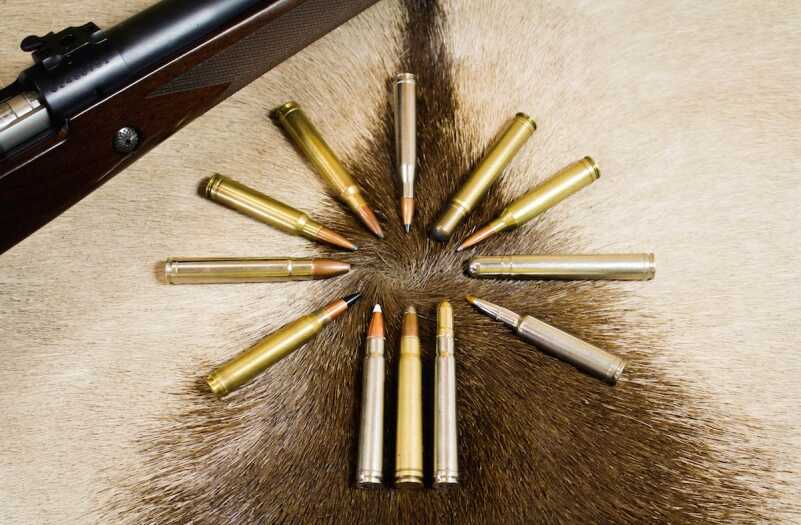
The mighty .375 H&H Magnum and its offspring. Clockwise from lower left: .300 Winchester magnum, .416 Remington Magnum, .338 Winchester Magnum, 8mm Remington Magnum, .300 H&H Magnum, .458 Winchester Magnum, .264 Winchester Magnum, .458 Lott and 7mm Weatherby Magnum.
The Quiet Parent
The .404 Jeffery was released somewhere in the middle to late Nineteen-Oughts; it’s a source of argument among cartridge historians, but suffice it to say that it was definitely available to hunters by 1909. It would be a workhorse among African Professionals and sportsmen alike, but it would stay out of the limelight – giving up the top billing to cartridges like the .375 H&H and .416 Rigby – until the end of the 20th century. Though the .404 is one of my all-time favorite safari cartridges, it is the children of the .404 Jeffery that would make a much bigger splash; when Remington released the .300 Remington Ultra Magnum in the late 1990s, it set a new benchmark for velocity. The Remington Ultra Magnum is based on a necked down .404 Jeffery, with nearly all the body taper removed to maximize case capacity, and it requires a magnum receiver. The 7mm RUM, .338 RUM and .375RUM weren’t far behind – giving very high velocities, among the highest from any major manufacturer. Winchester saw the wisdom of using the .404 Jeffery as a basis for development, but they went a different route: they shortened the case length down to fit in a .308 Winchester-length receiver, giving birth to the Winchester Short Magnum Series. While the .300 WSM is clearly the most popular of the trio, all three had an appeal to fans of the respective calibers. Remington also shortened things, releasing the Short Action Ultra Magnums, in 7mm and .308 caliber. Winchester wasn’t done there either, cutting the WSM case down even further to create the WSSM series – the Winchester Super Short Magnums. Available in .223, .243 and .25 caliber, the Super Short Magnums sort of resemble a fire hydrant, but in the right rifle, they sure do shoot. Nosler has also embraced the RUM design in their recent releases; the .26, .28 and .30 Nosler cartridges can be called the grandchildren of the .404, in that they are a 30-’06-length RUM case, giving just the most velocity to date out of a standard length receiver.
All in the Family
Reloaders can use these family trees to their advantage, creating one cartridge from another with a minimum of work. For example, you can create .257 Roberts cases (a rarity these days) from the popular 7×57 cases with ease. In a pinch, you can make .358 Norma brass from .375 H&H, or .358 Winchester cases from .338 Federal. I’ve used .30-’06 Springfield cases to make brass for my .318 Westley Richards (a more distant stretch, but totally possible), and I’ve used ’06 brass to make .338-’06 brass without issue. The .458 Winchester Magnum case can be converted into the wildcat .416 Taylor, and so on and so forth.
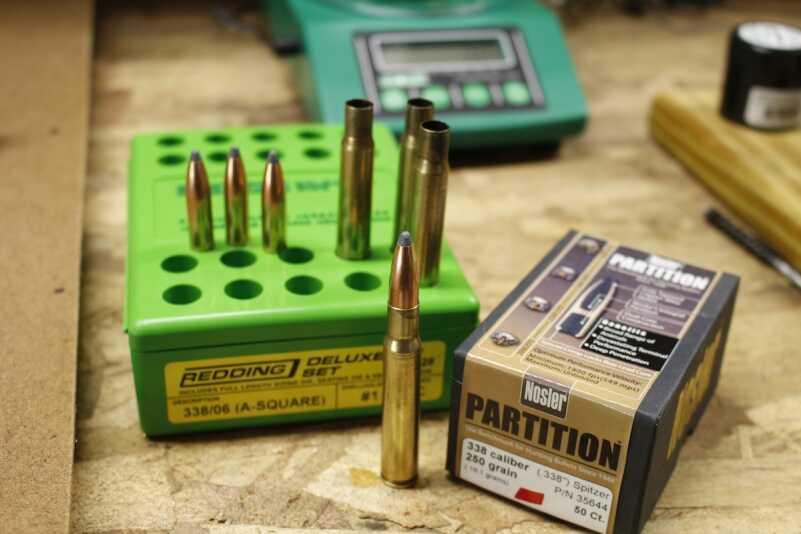
It’s easy to make .338-06 A-Square cases from .30-’06 brass; one pass through the Redding resizing die and you’ve got it!
Knowing the genealogy of your chosen cartridge can help you better understand its potential, and what exactly the designers were aiming for, so you don’t end up disappointed in the performance. It may also help you to find ammunition – or find the raw materials to create it – should things get scarce again!

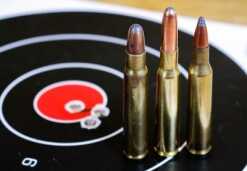
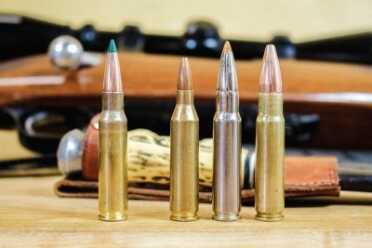
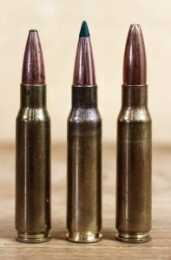
Good Article..However you forgot a few grandkids n TOTALY goofed on the Trio of WSMs It wasn’t a,Trio but Quads the 325 WSM…Seen reports but never personally of Wildcats 6mm 25 6.5 n 338 wouldn’t be surprised if somebody hasn’t done a 358 n 375..
There’s also the 6mm 6.5 n 8mm 06.
Great article. I have inherited a .30-.338, and am looking for ammunition. It is my understanding that the .30 belted newton is the same. That said, who or where am I able to find a supply?
All my best
Great article. Found it interesting and useful for folks who enjoy reloading.
Can some one comment on the linage of the 375 Ruger? A family case or clean sheet?
Thanks
Excellent article. Good info for the geek in me.
Very nicely done. Just the type of informal article you copy into a notes file for that odd occasion when someone asks “where did that cal. come from” or “who in the world thought that up?”.
Thanks for the great article. Have read most of this info before, but usually presented on a single family. Very comprehensive. Kudos!
Yes a very good article, entertaining
Liked the article … but does not the 7mm-08 deserve a mention… as it is so close to the 7×57 Mauser in practical use ?
“Once the dust settled, and Spain was evicted from North America, the U.S. Army’s Ordinance Department began to develop a new cartridge, with a case that borrowed some features of the Mauser design.”
It’s “Ordnance”…..it is shot from a hand held and/or operated weapon, fired from an artillery piece or tank or from a tube, dropped or fired from aircraft or launched from a torpedo tube, or on a missile or rocket. I may have missed an application or three……………….but it is not a rule or local variance or law “ordinance.”
You’re right about the difference between “ordnance” and “ordinance,” but in this case that may have been a typo, an auto-correction, or perhaps a “Freudian slip”.
The term “ordnance” comes from a misspelling of “ordinance” in a 16th-Century catalog of the British monarch’s material holdings, specifically weapons, ships, etc. and has been carried forward as a classification of such to our day.
Very good artcle
Very good article, informative and entertaining.